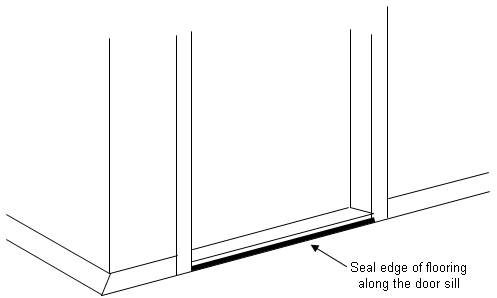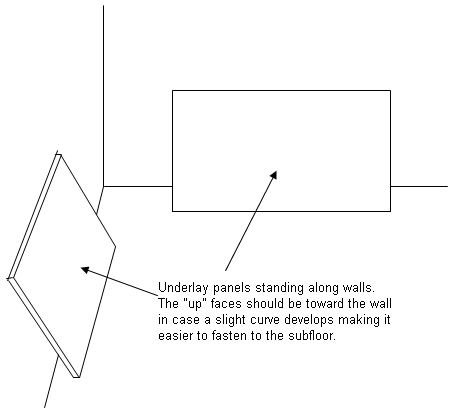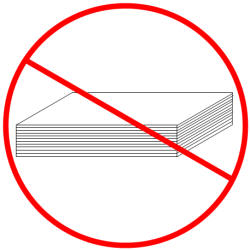Problem: Telegraphing Of Underlay Leading To Buckling Of Finishes - 1
Cause:
Expansion of underlay from exposure to excessive moisture, for example, curing of freshly poured basement concrete slabs.
Solutions:
Use correct underlay for the locations:
- Underlay manufacturers recommend specifically where their products should be installed. These recommendations are usually based upon, whatever the moisture conditions are at a site. They do not recommend application of underlay under extreme moisture conditions.
- Work should be scheduled near the end of construction. If high moisture is still retained by the subfloor it should be permitted to dry, or the house should be heated to dry the building materials to more suitable conditions before proceeding.
- Most manufacturers require that their underlay be protected from sources of excess heat such as furnaces or hot air ducts. Underlay must also be protected from excess moisture. Installation below grade or above unventilated crawl spaces in generally not recommended except for specific underlay products.
- Generally speaking, particleboards and oriented strand-boards are more sensitive to heat and moisture changes than plywood. Closely monitor the use of different underlay in various locations in the house, or take additional steps to seal the resilient (vinyl) flooring to protect it from moisture.
Ensure all edges of resilient (vinyl) flooring are sealed.
- Underlay is very susceptible to swelling in areas such as bathrooms and entrances where water either leaks or is tracked in. If joints are not sealed properly, or if flooring edges are not sealed well to the door sill, water can work its way under the resilient (vinyl) flooring and cause the underlay to swell as shown in Figure 26.

Figure 26 - Edge Sealing
- Seal seams in resilient (vinyl) flooring well, and keep traffic away until the adhesive to protect the underlay, is fully cured. Edges of resilient (vinyl) flooring must also be sealed along patio doors where condensation can run down and at door sills, bathtubs, toilets, shower bases, cabinets, vanities, and other locations where water or moisture could be present.
- Newer types of resilient (vinyl) flooring, known as loose-lay or interflex materials, continue to shrink for many weeks after being installed. It is critical that the edges of this type of flooring be securely fastened to the underlay. As the material shrinks and tightens, sealant used at doorways may pull loose, allowing water to get under the flooring. Check all seals at doorways approximately one month after installing loose-lay resilient (vinyl) flooring, and reseal them if necessary.
Protect and acclimatize underlay before installation, especially where there are extreme temperatures and moisture.
Problem: Telegraphing Of Underlay Leading To Buckling Of Finishes - 1.
Cause:
Expansion of underlay from exposure to excessive moisture, for example, curing of freshly poured basement concrete slabs.
- Underlay panels require conditioning or acclimatizing before they are installed. Virtually all underlay manufacturers recommend acclimatization of their product in the house prior to installation.
- They generally recommend storing panels flat over three supports in a dry covered area protected from heat and moisture extremes before, during and after installation.
Solutions:
Install panels after they have been allowed to acclimatize to room temperature and humidity, which may take 24 to 48 hours , depending on local conditions.
Figure 27a and 27b demonstrates one method that could be used to acclimatize panels.

Figure 27a - Acclimatizing Underlay Panels

Figure 27b - Incorrect Method Of Stacking Plywood
- Protect underlay from excess moisture, or it may start to swell even before it is installed. Do not store it in a cold, damp garage or on a recently poured slab. This can harm the stability of the underlay panels. If panels are stored outdoors, they must be protected from the elements.
